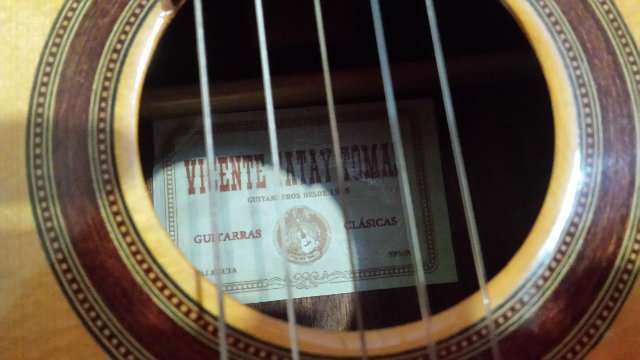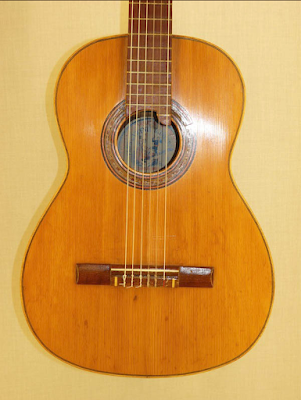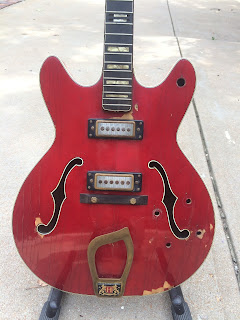I bought it for $150 from one of my "old church ladies" on the internet because I saw the pickup and wondered about its value as well as seeing the tuners which looked to be old Klusons (spoiler, they were).
 |
| Notice the metal nut riser |
 |
| "No Line" Kluson Deluxe Tuners from the late 40s |
First Impressions
I was actually a little disappointed when it arrived at my door because the neck was already at a fairly pleasant angle meaning I didn't get to do another neck reset. It was a fascinating guitar to take apart, I love the "forensics" of figuring out what somebody used it for and when it had been worked on.
First I noticed that it had a small plastic nut which was shimmed up by a Hoppin brand matchbox cover and then on top of that nut was a Grover Perfect Guitar Nut, a metal riser used to convert a regular guitar into a lap-steel instrument. There were also a couple indentations on the fretboard above the first fret where someone had moved the nut onto the fretboard with string tension.
Second it had a pickup labelled "Music Mike" which I had never heard of before and can hardly find any information on. The info I did find leads me to believe it was made in the late 1960s but since the CTS pot is soldered to a metal plate that I cannot remove without damaging it, I can't check the pot date to confirm.
The back, sides, fingerboard, and bridge are made of the same material, it has grain like mahogany but it is very dark like rosewood. I'll just refer to it as mahogany for the rest of this post. The bridge cracked at the saddle as the wood was not strong enough for the construction. The top, back, and sides are all solid wood which is super cool. Makes this guitar a great candidate for a restoration because it'll just ring and sound wonderful with those old solid woods.
Its also got some fairly wide brass frets which is cool, they've got some wear but still about 60% life left in them I would say. The neck is huge and chunky, like a baseball bat, but it tapers off near the headstock so it still remains fairly comfortable.
The finish has this almost over-sprayed look to it which makes me think it was sprayed over because it hardly has any checking in the finish and the top has the "orange peel" look to it. I'm not too terribly concerned about it but it was interesting
The Repair
I went ahead and tried my hand at fashioning a new bridge for the guitar, I had never done it before so it was a learning experience and the end result isn't anything to call home about. I'll get better. But it works and is holding perfectly which is all I need from it.
The Klusons had buttons that had shriveled up and were crumbling so I watched Dan Erlewine's video on installing new tuner buttons on Kluson tuners and I repeated his steps. The new tuner buttons are cream-colored plastic and I suspect will last a lot longer than the originals which were on the guitar. Crumbling tuners aren't worth much more than replaced buttons. I did keep everything else original though; I lubricated the tuners and got those solid brass shafts turning again.
I reinforced the bridge plate, which was starting to splinter, with a small sheet of African Blackwood which I got for free at my local wood store's scrap bin. It doesn't take a lot and it'll protect the bridge plate from more damage and keep the string tension from pulling the string balls into the top and warping it.
I marked out the location for the new bridge and used a chisel to carefully remove all the finish in that area so my bridge would be glued directly to wood which is definitely the way to go. These guitars often have their bridges glued onto the finish which leads to them coming back up and it usually isn't very pretty. I tried my hand at routing a saddle slot using a drill press with a router bit and while I got a good slot, its not slanted at all so I'm really relying on my compensated saddle to keep that intonation in check for me.
Finally I cleaned the guitar and oiled the fingerboard with a 30y/o bottle of Formby's Lemon Oil that I bought at an estate sale for fifty cents. The best tone comes from old oil, definitely (kidding, please don't lambaste me!)
Conclusion
I still do not know exactly what model of guitar this is as Marathon guitars are not well documented as they are a custom branded Kay-built guitar (headstock is a giveaway). But its super cool and sounds quite good for a ladder braced guitar of its size.
8/14/18: Correction, the guitar is from the late 1950s dating by the tuners
























































1 comment: